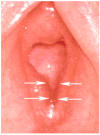Diagnosis of Child Sexual Abuse
- PMID: 39685755
- PMCID: PMC11642304
- DOI: 10.3390/jcm13237297
Diagnosis of Child Sexual Abuse
Abstract
Child sexual abuse (CSA) is a widespread and alarming issue, with an estimated global prevalence of 12-13% (affecting 18% of girls and 8% of boys). Despite its prevalence, many physicians working with children have insufficient knowledge of the medical diagnosis of CSA. This lack of expertise, combined with the sensitive and complex nature of these cases, often hampers proper identification and management. Diagnosing CSA is particularly challenging and requires specialized skills. A majority of children assessed for suspected sexual abuse present with normal genital and anal findings, which complicates the diagnostic process. Barriers such as professional isolation, societal taboos, and the sensitive nature of the subject often result in diagnostic failures. Accurate medical history taking, diagnosis, and documentation of findings are essential for ensuring a precise diagnosis, safeguarding children, and supporting legal proceedings. However, achieving these goals remains elusive without standardized guidelines and adequately trained healthcare professionals. Training of professionals in observing and reporting child sexual abuse is badly needed. This review explores the current state of medical diagnosis in suspected cases of CSA. This article is based on a selective review of pertinent literature retrieved from various databases, including PubMed and the overall index of the Quarterly Update.
Keywords: child sexual abuse; differential diagnosis; forensic documentation; medical diagnosis.
Conflict of interest statement
The authors declare no conflict of interest.
Figures







References
-
- Ogloff J.R.P., Cutajar M.C., Mann E. Child sexual abuse and subsequent offending and victimisation: A 45-year follow-up study. Trends Issues Crime Crim. Justice. 2012;79:413–422.
-
- Kaplan R., Adams J.A., Starling S.P. Medical Response to Child Sexual Abuse. A Resource for Professionals Working with Children and Families. STM Learning; St. Louis, MO, USA: 2011.
Publication types
LinkOut - more resources
Full Text Sources

